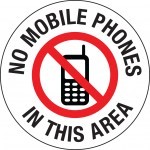Communication black out

A mandatory rule was recently issued by an international construction company, banning workers from carrying and using mobile phones anywhere on their Australian mining construction sites. Management confirmed the rule, which also applied bilaterally to their international construction sites, was sanctioned to prevent mobile phone initiated fire and explosion within a potential hazardous atmosphere.
The practical application of this rule on one particular site, created the expectation that in the event of an emergency, someone would run 50 metres to a site office to use a phone or UHF to call for medical assistance. Clearly in this case the mandated rule, while acknowledged as a genuine effort by the company to manage a perceived risk, caused risk of greater consequence and likely occurrence.
Many universal rules and controls on mobile phone use have unfortunately been based on an urban myth.
While recognising the uncontrolled use of mobile communication on any worksite may lead to unsafe or undesirable work practices, the reasoning for a total ban based on the potential of a static spark explosion is unverifiable.
In Australia it's illegal to use a hand-held phone when driving a car, yet motorists often ignore this recognisable hazard. Most people however won't use their mobile phone while they are refuelling their car's petrol tank, an action which is less likely to be as dangerous.
According to Dr Carl (http://www.abc.net.au/science/articles/2006/11/30/1799366.htm)
“Every month or so, I get an earnest email warning me of the hazards of using my mobile phone on the forecourt of a petrol station. Usually the email mentions the Shell Oil Company as its source and quotes the same three incidents of petrol fires while refuelling.
The first one has the mobile phone sitting on the boot - the phone rings, generating an instant ball of fire. The second episode has a person speaking on the phone, leading to nasty facial burns. The third occurrence has the phone in the pocket suddenly ring, causing unfortunate burns to the groin and thigh.
This email has been traced back to a hoax email that landed in the inbox of a Shell employee in Jamaica. He rebroadcast it, but with the Shell Company signature now on the email and this accidental unapproved signature gave the hoax more credibility."
Has a mobile phone ever sparked a petrol station fire?
No, according to the Australian Transport Safety Bureau; (ATSB) http://www.infrastructure.gov.au/roads/safety/publications/2005/pdf/static_fire.pdf
Between 1993 and 2004, there were 243 reported incidents of fires at petrol stations around the world. None of these incidents were caused by or related to mobile phone use.
Dr Carl goes on to say “And No, according to the Australian Mobile Telecommunications Association, and No, according the Robert Renkes, a spokesman for the American Petroleum Institute, who said, “We have not found a cell phone responsible for any fire since the beginning of mankind”.
And finally No, according to the popular Mythbusters TV show, which tried mightily to make a mobile phone explode a chamber full of petrol vapour, and failed.”
What research does tell us is;
- The temperatures needed for static-ignited fires are much higher than the normal operating temperatures of mobile phone components,
- Hot surfaces would only be an ignition concern if there is a phone or battery malfunction
- Mobile phones with non-genuine batteries may be at risk of over-heating and possibly generating a spark.
Why worry about the phone battery when you have batteries in your iPod, electronic car key, mini-torch, and what about the big 15 kg car battery that powers the electrics of your car?
Have a close look at your local service station. Many have mobile phone towers in the tall petrol price indicators, which stand right there in the drive way, a few metres from the petrol pump. The towers put out a lot more electrical current than your small mobile phone.
So what did set off those 243 petrol station fires?
According to the ATSB ‘most of the time static electricity was the culprit. We've all seen or felt a spark from clothing. If you are wearing synthetic clothes in the dryness of winter and are sliding in and out of the car, across the synthetic material of the car seat, then you can build up a big static charge. If the earthing wire on the petrol hose is broken, it is possible to discharge a visible spark if you touch the metal nozzle of the petrol hose to the metal neck of the petrol tank. This is even more dangerous, from the static electricity point-of-view, when filling up a small fuel drum.
In 2004, a leading oil company issued a memo to all retail site staff to explain the need for mobile phone warnings. It stated that, while the company has no experience of fires being caused in this manner, most mobile phone manufacturers do not certify their equipment as safe to use in hazardous areas.
One can assume that warnings are posted about the use of phones in petrol stations for two reasons. First, mobile phones are not designed with “Intrinsic Safety” to make them able to operate safely in truly hazardous inflammable vapour situations. Secondly, despite the evidence that mobile phones don't cause fires, petrol station owners have a fear of legal liability.
Consequently the mobile phone urban myth is now an undisputable and irrefutable truth, embedded in safety manuals and procedures throughout the world. Blacking out legitimate communication on work sites and delaying emergency notification.
It’s not the ban on mobile phones that is the issue. As I have pointed out, uncontrolled use of mobile phones can be a worksite hazard in itself; it is the fact that sites have applied a blanket mobile phone use policy based on incorrect information.
On the track into the Mossman Gorge in Far North Queensland is a ‘hanging boulder ‘which has been there for millions of years. Ten years ago someone jammed a little stick under the rock which creates the illusion of a balancing support. While it’s visually obvious the small 30cm x 1cm prop isn’t keeping the 20 ton boulder in place, the consequence of removing it, if the prop was providing any structural support , might be catastrophic to the courageous remover,. Needless to say over one million visitors have passed by the boulder over the past 10 years and no one has removed the stick.
A similar scenario applies to mobile phones and potential hazardous atmospheres. Who is going to challenge the urban myth and be the first to use their mobile phone at a petrol pump?
Will you?
References
Cite This Page:
http://www.amta.org.au/articles/No.Technical.Reason.to.Prohibit.the.Use.of.Mobile.Phones.at.Petrol.Stations
http://www.abc.net.au/science/articles/2006/11/30/1799366.htm
http://www.infrastructure.gov.au/roads/safety/publications/2005/pdf/static_fire.pdf
